Instruction
A Guide (Secret) to Better Putting
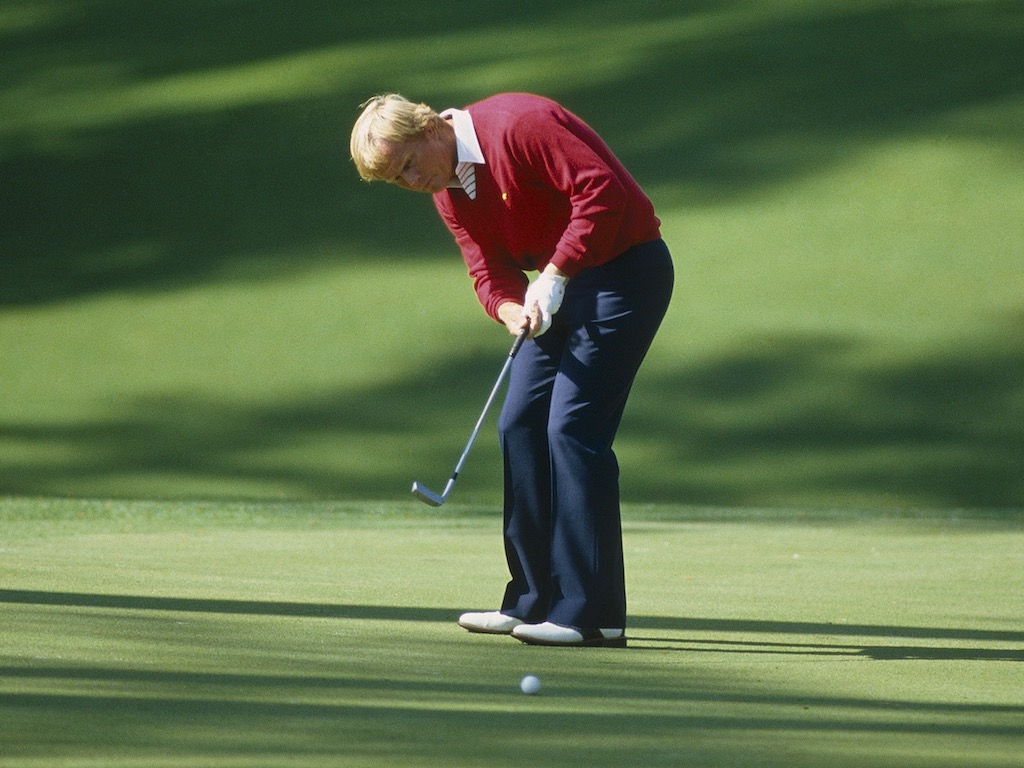
Putting is a part of the game where we can all do small things to get better. You don’t have to practice 40 hours a week or have a stroke that gets a perfect score on a SAM PuttLab. The universal answer is to simplify the approach as much as possible.
While being a world class putter is an art form, being competent at putting is probably the least physically daunting task in golf — aside from maybe driving the cart. Putting generally provides the most stress and frustration, however, as our results are almost never aligned with our exceptions, which drives us to create unnecessary roadblocks to success.
That being the case, let’s narrow this down to as few variables as possible and get ourselves holing more putts. First off, you need to have proper expectations. If you look at the PGA Tour averages for made putts, you will find that the rates of success overall are far lower than what we see on on TV on Sunday afternoon. That’s because we are seeing the best players in the world, who in a moment in time, are holing putts at a clip the average plus-handicap club champion couldn’t dream of during a near death experience on his way to walking into the light.
If you have ever seen golf balls rolled on a stimpmeter ramp (the device used to measure green speed), you have probably seen something shocking. Golf balls rolling perfectly — the perfect speed, on a perfect green, on a perfectly straight putt — sometimes miss on both sides of the hole on consecutive efforts.
This is a very important point. The farther you get from the hole, the less control you have over making the putt. That’s why actually making putts outside a few feet should not be your priority. Hitting the best putt possible is your only priority. Then be resigned that the putt will either go in or it won’t. This might seem defeatist, but it’s not; its just a perception change. If you judge yourself on whether the ball goes in or not, you are setting yourself up for failure. If you judge yourself on whether or not you hit a good putt, you will be more successful… and you’re going to make more putts.
This sounds like something you’d hear at a Tony Robbins positive thinking seminar, but it has proven successful for every one of my clients who has embraced it. So what’s the secret to hitting the best putt possible each time?
Simplify the process.
- Read the green to the best of your ability.
- Pick a line and do your best to set up to it.
- Do your best to hit the putt solid and at the right speed.
Reading the green is something that gets better with experience and practice. Some will be better than others, so this is an intangible thing that countless books are written about. My advice is simple; DON’T OVER THINK IT. Look at the terrain and get a general sense of where low point is in relation to the hole.
The reason why perfect green reading and perfect alignment are overrated is because there is no one line to the hole. The hole is over 4-inches wide and putts break differently with changes in speed and solidness of contact. I saw a video at the Scotty Cameron Putting Studio many years ago of dozens of PGA Tour players. There was a worm’s-eye camera on a 4-5 foot putt that was basically straight on the artificial grass. Few were aimed at the middle of the hole and many weren’t even aimed at the hole at all… but I didn’t see one miss.
So have a look at the terrain and be decent at lining up in the general direction that will give a chance for a well struck putt to go in or finish close enough for a tap in. Simple. After rambling on for several paragraphs, we get to the heart of how you can improve your putting. Narrow it down to doing your best to hit a solid putt at the right speed.
The “Right Speed”
I ask people after they addressed a putt how much attention they pay to line and speed. Any answer but 100 percent speed is wrong. You’ve already read the putt and lined up. Why is line any longer a variable? Plus, have you ever missed the line on a 20-foot putt by 5 feet? Maybe once in your life on a crazy green, but you sure as heck have left it 5-feet short and long on several occasions.
Imagine I handed you a basketball and said shoot it in the basket. Or what if I told you to toss a crumpled piece of paper into the trash? Having the requisite coordination is an acquired skill, but you wouldn’t grind over innocuous details when it came to the feel of making the object go the right distance. You’d react to the object in your hand and the target for the right speed/distance.
Putting is no different, save one variable. There’s the sense and feel of how the the green interacts with the ball, and that’s a direct result of how solidly you hit the putt. If you use X amount of force and it goes 18 feet one effort and 23 feet the next, how are you ever going to acquire speed control? That is the mark of almost every poor lag putter. They don’t hit putts consistently solid, so they never acquire the skill of distance control.
Since speed is a learned reaction to the terrain/target and consistency is a direct result of how consistently solid you strike the ball, that is what we’re left with.
Learn to Hit Putts More Solid
The road to better putting is as simple as hitting your putts more solid. Put most/all of your effort into what it takes to hit more putts solid. Now for each individual, it’s less about doing what’s right. Instead, it’s about avoiding movements and alignments that make it difficult to hit the ball solid. It would take an encyclopedia to cover all of the issues that fall into this category, so I will list the most common that will cover more than 90 percent of golfers.
The most common one I see — and it is nearly universal in people who are plagued by poor lag putting — is excess hip rotation. Sometimes there’s even an actual weight shift. Think of it this way; take a backstroke and stop. Rotate your hips 20 degrees without moving anything else. The putter and the arc is now pointed left of your intended line. You have to shove it with your arms and hands not to pull it. Good luck hitting it solid while doing all of that.
I had a golf school in Baltimore and told this story. Ten of the 15 people there assured me they didn’t do that. After 8 people had putted, we were 8-for-8. No. 9 said, “There is no ******* way I am going to move my hips after watching this.”
The entire group laughed after his putt told him he was wrong. The last 6 did everything they could to avoid the fault. We went 15 for 15. Many people are unaware that this issue is so dire. If you add the people that are unaware they have this issue, we are near 100 percent of golfers. I have gotten emails from 8-10 of them telling me how much their putting improved after all they did was focus on minimizing hip rotation and just hitting the ball solid.
This issue is not just the bane of average golfers; I’ve had several mini-tour players with putting issues improve with this. We are all aware Fred Couples would have won many more majors if not for a career-long battle with his putter. Watch the next time he misses a 6-foot putt to the left. As you will see, it’s not just a problem for a high-handicappers.
The best way to judge and practice avoiding this, it putting with an alignment stick in you belt loops. If your hips rotate too much, the stick will definitely let you know.
Other issues include the well know chest/sternum coming up too soon in an effort to see the ball go in the hole, as well as:
- Not aligning the putter shaft properly with the lead arm
- Grip pressure issues (too much and too little)
- Too much tension in neck and shoulders
- Poor rhythm
- Long back stroke
I could go on and on and on. The main point; find out why you aren’t hitting putts solid and do whatever it takes to do so, even if it’s something crazy like a super wide-open stance (with my tongue firmly implanted in my cheek). See the Jack Nicklaus picture at the top of the story.
- LIKE369
- LEGIT37
- WOW5
- LOL1
- IDHT0
- FLOP1
- OB0
- SHANK20
Instruction
The Wedge Guy: The easiest-to-learn golf basic

My golf learning began with this simple fact – if you don’t have a fundamentally sound hold on the golf club, it is practically impossible for your body to execute a fundamentally sound golf swing. I’m still a big believer that the golf swing is much easier to execute if you begin with the proper hold on the club.
As you might imagine, I come into contact with hundreds of golfers of all skill levels. And it is very rare to see a good player with a bad hold on the golf club. There are some exceptions, for sure, but they are very few and very far between, and they typically have beat so many balls with their poor grip that they’ve found a way to work around it.
The reality of biophysics is that the body moves only in certain ways – and the particulars of the way you hold the golf club can totally prevent a sound swing motion that allows the club to release properly through the impact zone. The wonderful thing is that anyone can learn how to put a fundamentally sound hold on the golf club, and you can practice it anywhere your hands are not otherwise engaged, like watching TV or just sitting and relaxing.
Whether you prefer an overlap, interlock or full-finger (not baseball!) grip on the club, the same fundamentals apply. Here are the major grip faults I see most often, in the order of the frequency:
Mis-aligned hands
By this I mean that the palms of the two hands are not parallel to each other. Too many golfers have a weak left hand and strong right, or vice versa. The easiest way to learn how to hold the club with your palms aligned properly is to grip a plain wooden ruler or yardstick. It forces the hands to align properly and shows you how that feels. If you grip and re-grip a yardstick several times, then grip a club, you’ll see that the learning curve is almost immediate.
The position of the grip in the upper/left hand
I also observe many golfers who have the butt of the grip too far into the heel pad of the upper hand (the left hand for right-handed players). It’s amazing how much easier it is to release the club through the ball if even 1/4-1/2″ of the butt is beyond the left heel pad. Try this yourself to see what I mean. Swing the club freely with just your left hand and notice the difference in its release from when you hold it at the end of the grip, versus gripping down even a half inch.
To help you really understand how this works, go to the range and hit shots with your five-iron gripped down a full inch to make the club the same length as your seven-iron. You will probably see an amazing shot shape difference, and likely not see as much distance loss as you would expect.
Too much lower (right) hand on the club
It seems like almost all golfers of 8-10 handicap or higher have the club too far into the palm of the lower hand, because that feels “good” if you are trying to control the path of the clubhead to the ball. But the golf swing is not an effort to hit at the ball – it is a swing of the club. The proper hold on the club has the grip underneath the pad at the base of the fingers. This will likely feel “weak” to you — like you cannot control the club like that. EXACTLY. You should not be trying to control the club with your lower/master hand.
Gripping too tightly
Nearly all golfers hold the club too tightly, which tenses up the forearms and prevents a proper release of the club through impact. In order for the club to move back and through properly, you must feel that the club is controlled by the last three fingers of the upper hand, and the middle two fingers of the lower hand. If you engage your thumbs and forefingers in “holding” the club, the result will almost always be a grip that is too tight. Try this for yourself. Hold the club in your upper hand only, and squeeze firmly with just the last three fingers, with the forefinger and thumb off the club entirely. You have good control, but your forearms are not tense. Then begin to squeeze down with your thumb and forefinger and observe the tensing of the entire forearm. This is the way we are made, so the key to preventing tenseness in the arms is to hold the club very lightly with the “pinchers” — the thumbs and forefingers.
So, those are what I believe are the four fundamentals of a good grip. Anyone can learn them in their home or office very quickly. There is no easier way to improve your ball striking consistency and add distance than giving more attention to the way you hold the golf club.
More from the Wedge Guy
- The Wedge Guy: Golf mastery begins with your wedge game
- The Wedge Guy: Why golf is 20 times harder than brain surgery
- The Wedge Guy: Musings on the golf ball rollback
- LIKE83
- LEGIT13
- WOW5
- LOL1
- IDHT0
- FLOP4
- OB1
- SHANK8
Instruction
Clement: Stop ripping off your swing with this drill!

Not the dreaded headcover under the armpit drill! As if your body is defective and can’t function by itself! Have you seen how incredible the human machine is with all the incredible feats of agility all kinds of athletes are accomplishing? You think your body is so defective (the good Lord is laughing his head off at you) that it needs a headcover tucked under the armpit so you can swing like T-Rex?
- LIKE0
- LEGIT2
- WOW2
- LOL0
- IDHT0
- FLOP0
- OB0
- SHANK2
Instruction
How a towel can fix your golf swing
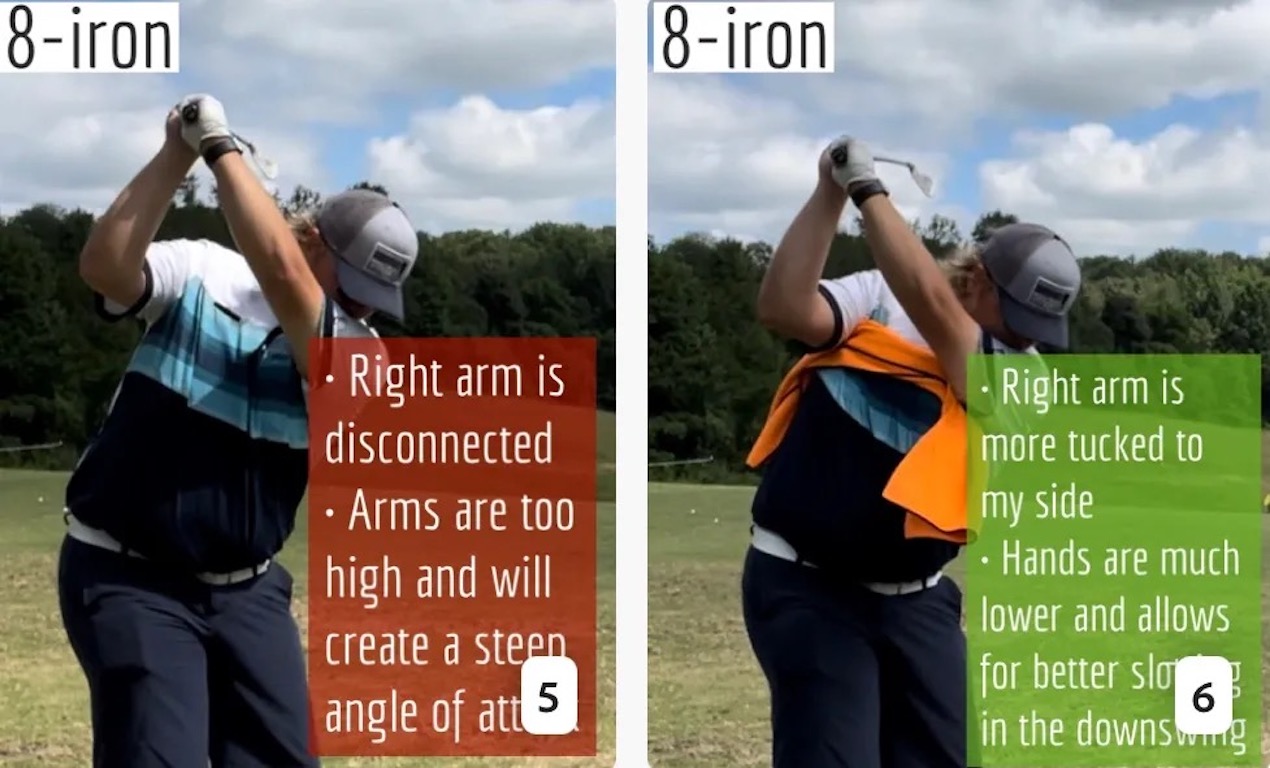
This is a classic drill that has been used for decades. However, the world of marketed training aids has grown so much during that time that this simple practice has been virtually forgotten. Because why teach people how to play golf using everyday items when you can create and sell a product that reinforces the same thing? Nevertheless, I am here to give you helpful advice without running to the nearest Edwin Watts or adding something to your Amazon cart.
For the “scoring clubs,” having a solid connection between the arms and body during the swing, especially through impact, is paramount to creating long-lasting consistency. And keeping that connection throughout the swing helps rotate the shoulders more to generate more power to help you hit it farther. So, how does this drill work, and what will your game benefit from it? Well, let’s get into it.
Setup
You can use this for basic chip shots up to complete swings. I use this with every club in my bag, up to a 9 or 8-iron. It’s natural to create incrementally more separation between the arms and body as you progress up the set. So doing this with a high iron or a wood is not recommended.
While you set up to hit a ball, simply tuck the towel underneath both armpits. The length of the towel will determine how tight it will be across your chest but don’t make it so loose that it gets in the way of your vision. After both sides are tucked, make some focused swings, keeping both arms firmly connected to the body during the backswing and follow through. (Note: It’s normal to lose connection on your lead arm during your finishing pose.) When you’re ready, put a ball in the way of those swings and get to work.
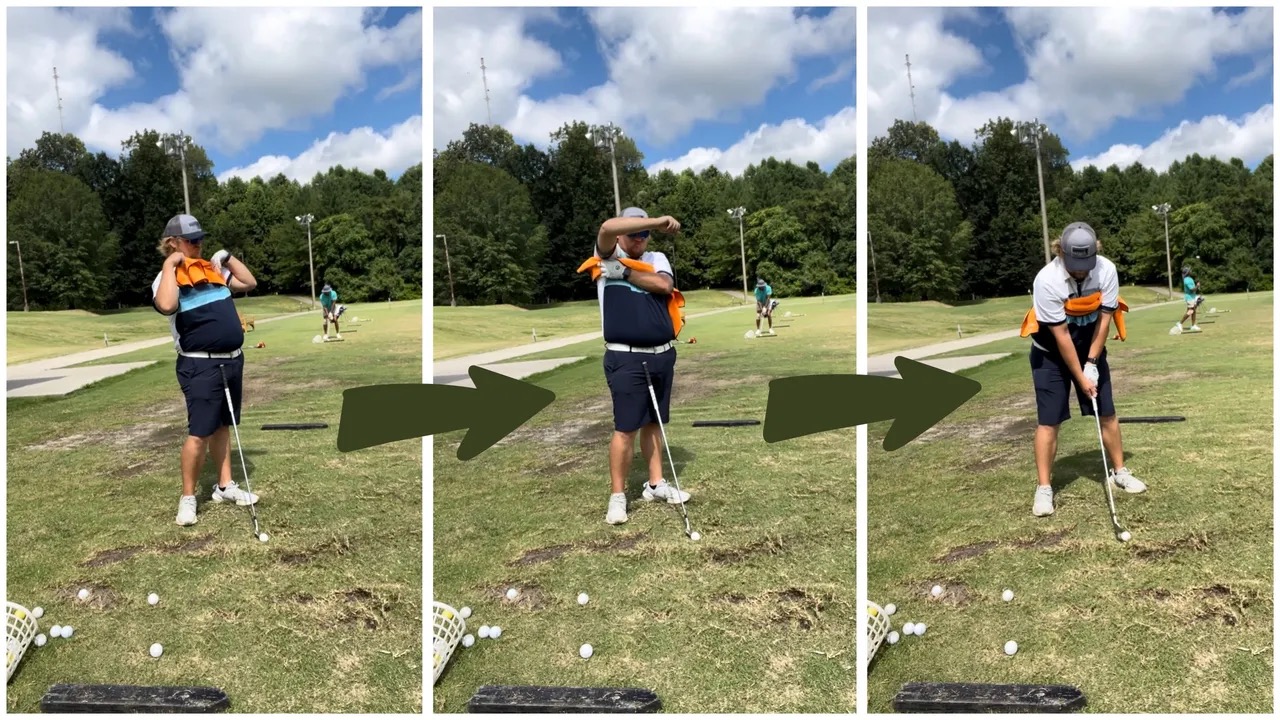
Get a Better Shoulder Turn
Many of us struggle to have proper shoulder rotation in our golf swing, especially during long layoffs. Making a swing that is all arms and no shoulders is a surefire way to have less control with wedges and less distance with full swings. Notice how I can get in a similar-looking position in both 60° wedge photos. However, one is weak and uncontrollable, while the other is strong and connected. One allows me to use my larger muscles to create my swing, and one doesn’t. The follow-through is another critical point where having a good connection, as well as solid shoulder rotation, is a must. This drill is great for those who tend to have a “chicken wing” form in their lead arm, which happens when it becomes separated from the body through impact.
In full swings, getting your shoulders to rotate in your golf swing is a great way to reinforce proper weight distribution. If your swing is all arms, it’s much harder to get your weight to naturally shift to the inside part of your trail foot in the backswing. Sure, you could make the mistake of “sliding” to get weight on your back foot, but that doesn’t fix the issue. You must turn into your trial leg to generate power. Additionally, look at the difference in separation between my hands and my head in the 8-iron examples. The green picture has more separation and has my hands lower. This will help me lessen my angle of attack and make it easier to hit the inside part of the golf ball, rather than the over-the-top move that the other picture produces.
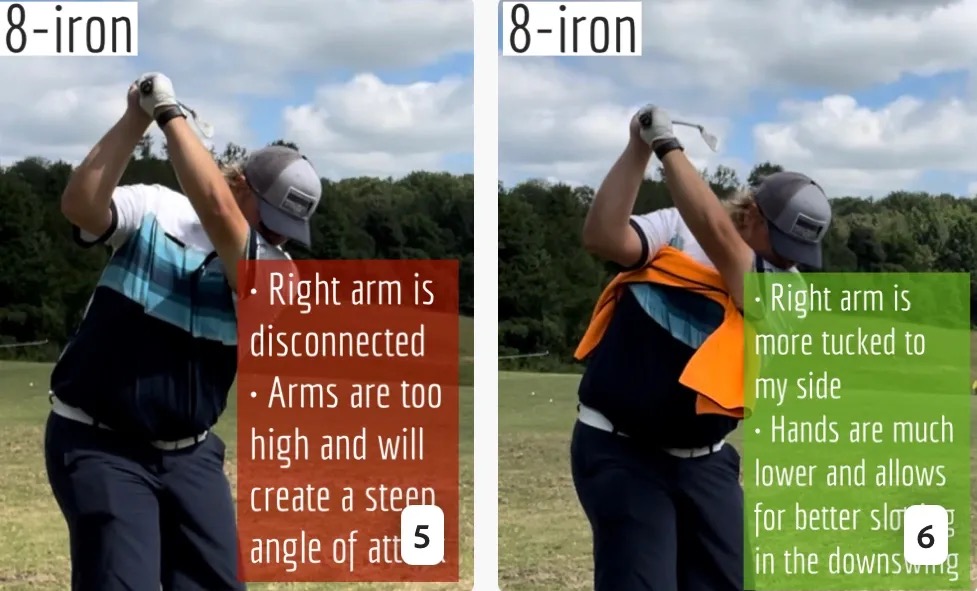
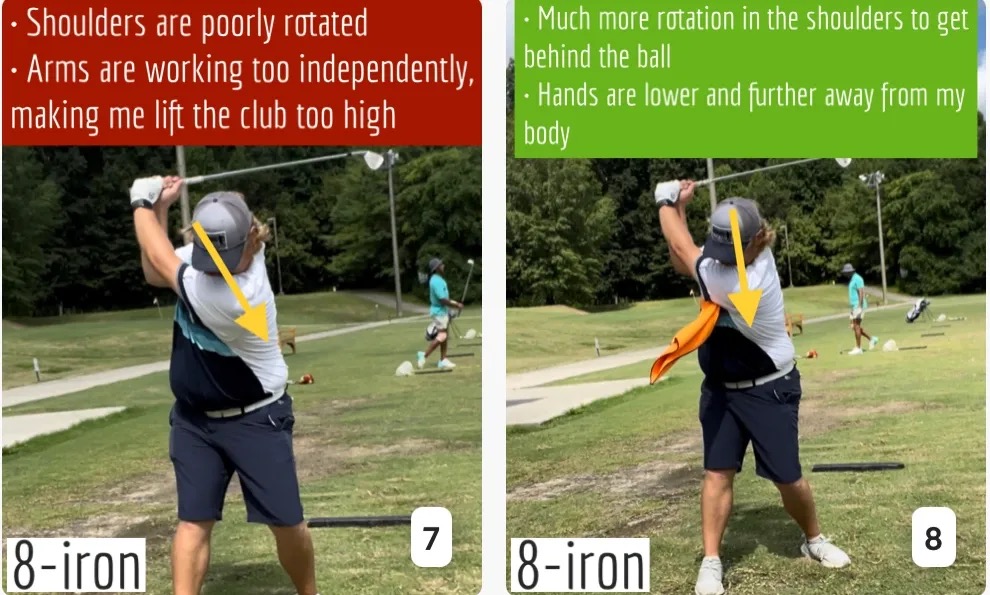
Stay Better Connected in the Backswing
When you don’t keep everything in your upper body working as one, getting to a good spot at the top of your swing is very hard to do. It would take impeccable timing along with great hand-eye coordination to hit quality shots with any sort of regularity if the arms are working separately from the body.
Notice in the red pictures of both my 60-degree wedge and 8-iron how high my hands are and the fact you can clearly see my shoulder through the gap in my arms. That has happened because the right arm, just above my elbow, has become totally disconnected from my body. That separation causes me to lift my hands as well as lose some of the extension in my left arm. This has been corrected in the green pictures by using this drill to reinforce that connection. It will also make you focus on keeping the lead arm close to your body as well. Because the moment either one loses that relationship, the towel falls.
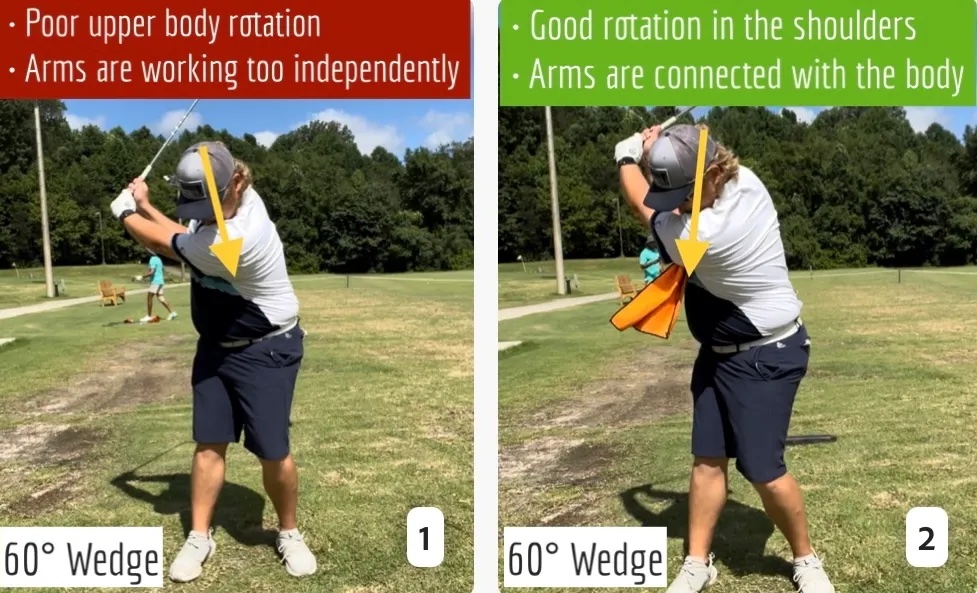
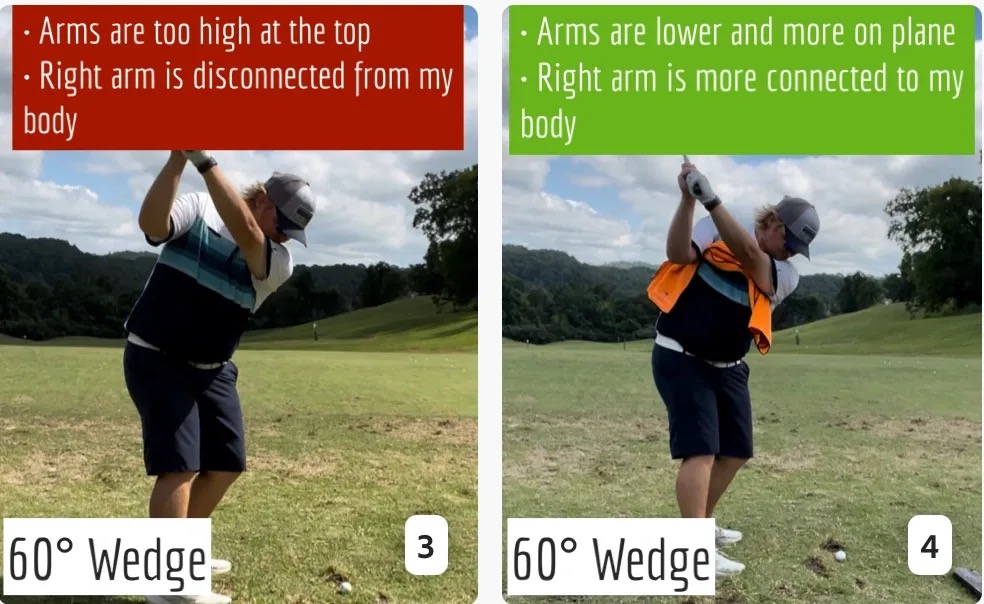
Conclusion
I have been diligent this year in finding a few drills that target some of the issues that plague my golf game; either by simply forgetting fundamental things or by coming to terms with the faults that have bitten me my whole career. I have found that having a few drills to fall back on to reinforce certain feelings helps me find my game a little easier, and the “towel drill” is most definitely one of them.
- LIKE12
- LEGIT2
- WOW2
- LOL0
- IDHT0
- FLOP2
- OB0
- SHANK8
-
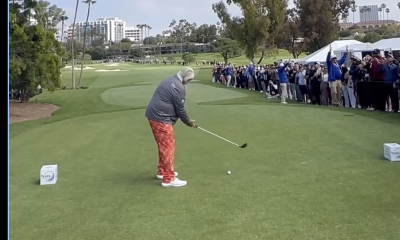
 19th Hole2 weeks ago
19th Hole2 weeks agoJohn Daly stuns fans into silence with brutal opening tee shot on PGA Tour Champions
-
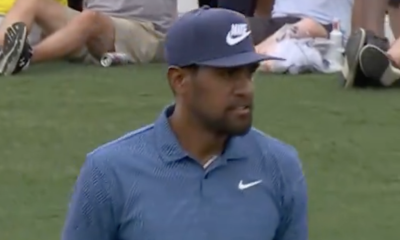
 19th Hole1 week ago
19th Hole1 week agoThings got heated at the Houston Open between Tony Finau and Alejandro Tosti. Here’s why
-

 19th Hole1 day ago
19th Hole1 day agoTiger Woods arrives at 2024 Masters equipped with a putter that may surprise you
-

 19th Hole6 days ago
19th Hole6 days agoReport: Tiger Woods has ‘eliminated sex’ in preparation for the 2024 Masters
-

 19th Hole3 weeks ago
19th Hole3 weeks ago2-time major champ announces shock retirement from the sport at age of 33
-

 19th Hole2 weeks ago
19th Hole2 weeks agoCharlie Woods finds it tough going on American Junior Golf Association debut
-

 19th Hole1 week ago
19th Hole1 week agoAddiction, spinal fusion, and scam artists – Everything Anthony Kim revealed in candid interview with David Feherty
-

 19th Hole5 days ago
19th Hole5 days agoAnthony Kim says doctors told him that he ‘may not have much time left’ ahead of LIV return











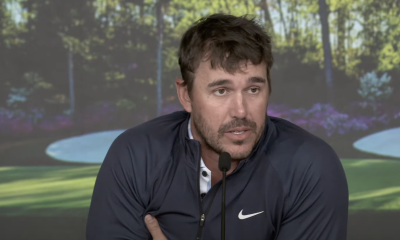















Sam
Dec 28, 2017 at 7:46 pm
This article is only a secret if you’ve never taken any golf instruction before. I’m hoping the editors of GolfWrx sets a higher bar for the content of any instruction piece.
Willy Wonka
Dec 28, 2017 at 10:07 pm
The editors of Golfwrx are not responsible for you not being smart enough to understand the point of the article. Obviously many others were.
BigE
Dec 27, 2017 at 6:56 am
Great article. I’ll definitely incorporate this philosophy into my putting next summer. Although I’m pretty sure my hips don’t move – because I’m a sidesaddle putter whose hips are already squatter to my target tine!
BigE
Dec 27, 2017 at 6:57 am
oops…I meant “target line”….
Bob Jacobs
Dec 26, 2017 at 8:55 am
Quiet hips are one of the number one things I focused on towards the end of this season and it did make a diffference. Not a shocking difference because it’s still a work in progress. I’m also watching for any hip movement when I watch the pros and most have close to NONE. I watch my buddies and as Monte states, they almost ALL move their hips. Probably the simplest fix which is the good news here.
BigE
Dec 26, 2017 at 8:23 am
I loved this article. My goal this summer is to give myself a break and not feel like my putts have to be perfect. I’m going to do what Monte says and work on speed. I don’t need to worry about the hips issue as I’m a sidesaddle putter which means my body isn’t moving with the exception of my right arm!
8thehardway
Dec 25, 2017 at 11:35 pm
Excellent article that captures what I see with my buddies and most everyone else. To amplify one of your points…
“have a look at the terrain” is a big deal, especially on longer putts. The terrain is a test, checking it out gives me the answers. Take 20 seconds to walk it out, get a sense of major breaks and the last few feet by the cup. Even if I get minimal info, the effort itself calms and reorients me to a different aspect of the game; it’s also the hallmark of a competent putter, a self-reinforcing cycle that helped me ‘fake it ’till I made it.’
As to goals, on medium and long putts my goal is to entertain… the longer my putt has the potential to go in, the more excitement it generates; sinking it is just a bonus.
GolfManiac
Dec 19, 2017 at 9:34 pm
——–>https://officialgolfmaniac.weebly.com/<——— CHECK OUT THIS WEBSITE FOR GREAT PRODUCTS TO HELP YOU IMPROVE ON GOLFING
RBImGuy
Dec 17, 2017 at 5:02 am
I do know the secret to putting and this must be one of the worst guides I read on that topic.
Willy Wonka
Dec 25, 2017 at 9:35 pm
All is forgiven. Please come back to work.
Cary
Dec 26, 2017 at 9:28 am
Did you know that envy is one of the 7 deadly sins ?
dlygrisse
Dec 27, 2017 at 3:31 pm
I do know the secret to trolling, and this must be one of the worst attempts I have seen on the topic.
albert
Dec 13, 2017 at 3:24 pm
Monte…. 42% of golf strokes are putting strokes…. and it’s incongruous if not insane to think that one putter can efficiently and effectively putt from all distances and on all greens.
I carry two putters and one less useless iron or hybrid in my WITB. A putter for long putts and a putter for shorter putts, and also depending on green speed.
An 8802-style heel-shafted putter and a Cashin-style putter… and both costing less than $100 total. I skin those with Scotty’s and that ilk of fantasy status putters. It’s hilarious…. 🙂
Richard Luczak
Dec 13, 2017 at 3:35 pm
Says the 26 handicap….
albert
Dec 13, 2017 at 3:47 pm
… actuallly 6ix ….:p
Ed L.
Dec 13, 2017 at 11:03 am
Hitting putts solid? Really?
Let’s define solid: 1) ball is impacted by the c.o.g. of the club (sweetspot), 2) club face is perpendicular to the direction of the swing, 3) loft is not added or substracted from the clubface at impact.
Solid contact is only one element.
Monte Scheinblum
Dec 13, 2017 at 1:13 pm
You don’t think I’m aware of those things?
It’s that kind of over tech talk to average golfers why they don’t get better and don’t want to take lessons.
Instructors need to acquire knowledge so they can simplify the process for the average golfer…not parrot what they read in a disseration.
albert
Dec 13, 2017 at 3:35 pm
Monte…. and competent teacher will be science knowledgeable to properly diagnose the desperate golfer’s problems… just as a medical doctor will not give the patient the gory details of their disease; only explaining the treatment and providing hope.
Science is intruding into objective knowledge starved game of golf. The old veteran teachers are struggling to survive the onslaught of Trackman, 3D video analysis, force plate analysis, even psychological remedies. The young gun golf teachers are loaded with scientific weapons while the old dogs are overloaded with dubious experience and good golf stories.
Richard Luczak
Dec 13, 2017 at 3:44 pm
Are you agreeing with him? Or did you just disagree and make his point…?
albert
Dec 13, 2017 at 3:48 pm
…. both ….;)
Richard Luczak
Dec 13, 2017 at 1:17 pm
You sound like the quintessential 5-7 handicap, Ed: just enough knowledge to be dangerous, but not enough knowledge to be any good.
albert
Dec 13, 2017 at 3:27 pm
…. and ignorance is golffing bliss …?
DB
Dec 13, 2017 at 9:06 am
I’m going to look into this hip rotation issue. Definitely agree with finding the “right speed”.
I moved to using a line on the ball, and changed my routine to where I completely forget about line once I have my ball lined up. Everything after that is just looking at the hole and thinking about speed. My putting stats have improved significantly.
CP
Dec 12, 2017 at 9:53 pm
What about all the people who are using putters that aren’t aimed where they think they’re aiming? The only way to truly know where you’re aiming is with a laser and a mirror.
Monte Scheinblum
Dec 13, 2017 at 1:15 pm
Reread the section where I saw the video at the Cameron putting studio.
Alignment needs to be competent, not perfect.
COGolfer
Dec 12, 2017 at 3:22 pm
I read the article without looking at the author. When I got to ‘Excess hip rotation…’ I knew it had to be Monte.
For me, stopping the hips has increased the odds of solid strikes with the putter. Now I just need to work on the mental part of accepting the outcome.
G
Dec 12, 2017 at 1:16 pm
Video maybe?
juststeve
Dec 12, 2017 at 11:19 am
Excellent Monte!
bill
Dec 12, 2017 at 10:57 am
Thank you for this very insightful article based on your personal experience as a golf teacher. However, you did not delve into the ‘best putter’ controversy.
What is your view on the difference between a $400 Scotty and a $40 Walmart putter.. other than $360? Thanks.
JD
Dec 12, 2017 at 11:18 am
Depends on the person. Putting is more about having something you like looking down at more than anything. If you “feel” more confident with a $400 putter, then you’ll likely do better.
Technically speaking, if a $40 walmart putter plays at the swing weight you’re comfortable with, puts a good roll on the ball, and has atleast some forgiveness, you should putt the same with the two putters. But that’s not the case. Typically you get what you pay for when you buy a Betti or Scotty or Toulon, but for many an $80 Cleveland Huntington Beach will do just as well.
Just picture yourself with a 6 footer that you need to knock down… what do you want to be looking down at? Go buy that putter. For me its a 2003 Scotty Cameron Studio Stainless.
Monte Scheinblum
Dec 12, 2017 at 1:06 pm
It’s all personal preference. It’s like asking what’s better, a really good fast food burger, or an expensive fancy filet at a restaurant in Paris with a sauce you may not like.
siggy
Dec 12, 2017 at 5:56 pm
Monte….. it’s interesting you equate putters with comfort food!
Personally, I compare it to wine where a decent cheaper wine can be superior to an expensive snobby skunky chateau wine.
À chacun ses goûts or “to each one his taste” and is used to mean “to each his own” or “there’s no accounting for taste.”
How about a Kramski putter embedded with precious stones of your choice like sapphires, diamonds, rubies, etc., etc.? … lol
Monte Scheinblum
Dec 12, 2017 at 8:40 pm
Brilliant